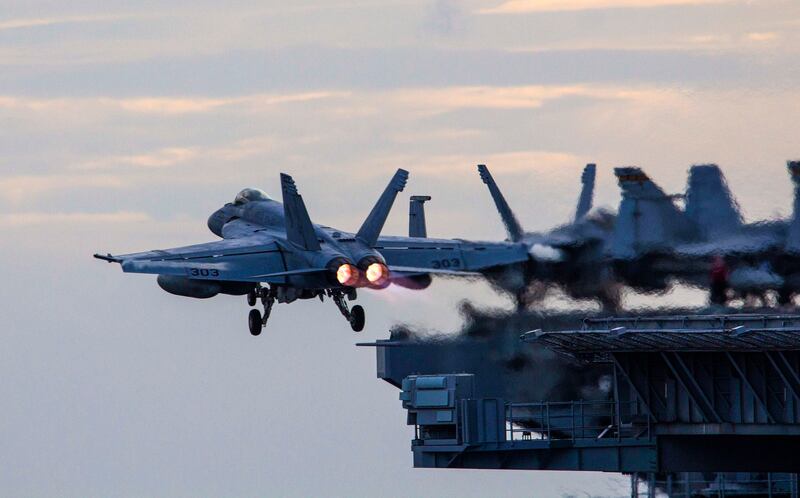Two U.S. aircraft carrier strike groups conducted dual operations in the South China Sea on Tuesday, the latest in a series of U.S. military maneuvers in those turbulent waters.
In a sign of growing international pushback against China's expansive claims and assertive behavior, French Defense Minister Florence Parly also confirmed Monday that a French nuclear attack submarine and an accompanying support ship had recently completed a patrol in the South China Sea.
The operations point to the expanding role of non-claimant states in the South China Sea, which is contested by China, the Philippines, Taiwan, Vietnam, Brunei, and Malaysia.
Earlier in January, Nikkei Asia reported that Germany is considering sending a naval frigate through the South China Sea as early as this coming summer – indication of an increasing willingness among such states to deploy military assets to back up their diplomatic messaging.
The United States is at the forefront of this pushback.
The deployment of the Theodore Roosevelt Carrier Strike Group and the Nimitz Carrier Strike Group was the second dual aircraft carrier operation by the U.S. in the South China Sea in little over six months.
“The ships and aircraft of the two strike groups coordinated operations in a highly trafficked area to demonstrate the U.S. Navy's ability to operate in challenging environments,” the U.S. Navy said in a statement.
"Through operations like this, we ensure that we are tactically proficient to meet the challenge of maintaining peace and we are able to continue to show our partners and allies in the region that we are committed to promoting a Free and Open Indo-Pacific,” Rear Adm. Doug Verissimo, commander of the Theodore Roosevelt Carrier Strike Group, was quoted as saying.
The last dual carrier operation in the South China Sea was in July 2020, involving the USS Ronald Reagan and USS Nimitz.

Chinese Foreign Ministry Spokesman Wang Wenbin criticized Tuesday’s operation, noting “the U.S. has frequently sent warships and aircraft to the South China Sea as a show of force, which is not conducive to regional stability and peace.”
“China will continue to take necessary measures to firmly safeguard its national sovereignty and security, and will work with regional countries to resolutely protect the peace and stability of the South China Sea,” Wang said.
Last week, the USS John S. McCain Arleigh Burke-class guided missile destroyer conducted a freedom of navigation operation (FONOP) in the Chinese-occupied Paracel Islands, which a Chinese military spokesman described as "seriously violating China's sovereignty and security." It was the first such FONOP since President Joe Biden took office last month.
And earlier in January, the Theodore Roosevelt Carrier Strike Group carried out routine operations in the South China Sea, including maritime strike exercises and coordinated tactical training between surface and air units.
Other countries are joining the fray too.
In series of tweets on Monday, French Defense Minister Florence Parly revealed that the SNA Emeraude, a nuclear attack submarine, recently completed operations in the South China Sea.
According to Parly, the SNA Emeraude was accompanied by a support ship, the BSAM Seine.
“This extraordinary patrol has just completed a passage in the South China Sea. A striking proof of the capacity of our French Navy to deploy far away and for a long time together with our Australian, American and Japanese strategic partners,” she said.
Parly added that operation was meant to affirm international law, and that France intends to protect its sovereignty and interests in the Indo-Pacific region, where it still controls numerous territories.
U.S. allies Japan and Australia have also participated in military exercises in the South China Sea in recent months.
Meanwhile, a growing number of non-claimant powers have formally challenged China's maximalist South China Sea claims in the United Nations, including the U.S. but also Australia, Indonesia, France, Germany, and Japan.
For instance, in September 2020 the United Kingdom, France, and Germany submitted joint diplomatic notes to the U.N. rejecting China's baseline claims in the Paracel Islands, its "historic rights" claims, and other aspects of China's position.
According to specialists, outside countries have long pursued their interests in this contested body of water. Hoang Viet, an expert on the South China Sea, told RFA that European countries are particularly concerned about upholding international law and in particular the navigational freedoms granted by international law.
